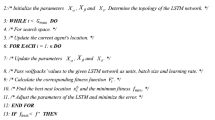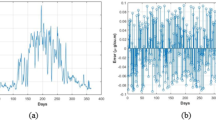Abstract
The concentration of air pollutants is closely related to people’s production and life. Air quality prediction is the premise for environmental management departments to make decisions and put forward pollution control measures. A novel air pollutant prediction model was proposed in this paper to predict air pollutant concentration more accurately. Firstly, the data were decomposed into several subsequences by a complete ensemble empirical mode decomposition with adaptive noise and calculated the sample entropy of the subsequence. Secondly, variational mode decomposition is used to decompose the sequence with the highest sample entropy, and a fast correlation-based filter is used to select the features of the second decomposed sequence and the remaining sequences. Then, a multi-layer perceptron is used to predict the processed quadratic decomposition sequence, and a gated recurrent unit is used to predict the remaining sequences. According to the experimental results, three main conclusions can be drawn. First, through two groups of comparative experiments, it is found that the model has a good prediction effect. Second, after adding the decomposition algorithm, the average improvement levels of mean absolute error and root mean squared error were 44.50% and 34.77%, respectively. Third, after the re-decomposition of intrinsic mode functions 1, the mean absolute percentage error can be reduced by 22.98% on average on the original basis. The results of this study can provide a valuable reference for the prediction of atmospheric pollutants.







Similar content being viewed by others
Data availability
The datasets used or analyzed during the current study are available from the corresponding author on reasonable request.
References
Alcaraz R, Rieta JJ (2010) A review on sample entropy applications for the non-invasive analysis of atrial fibrillation electrocardiograms Biomedical Signal Processing and Control 5(1):1–14. https://doi.org/10.1016/j.bspc.2009.11.001
Cabaneros S, Calautit J, Hughes B (2020) Spatial estimation of outdoor NO2 levels in Central London using deep neural networks and a wavelet decomposition technique Ecological Modelling 424109017
Chung J, Gulcehre C, Cho K, Bengio Y (2014) Empirical Evaluation of Gated Recurrent Neural Networks on Sequence Modeling.[J]. CoRR. abs/1412.3555(abs/1412.3555)
Dragomiretskiy K, Zosso D (2014) Variational mode decomposition[J]. IEEE Trans. Signal Processing 62(3):531–544
Fan L, Ji Y, Wu G (2021) Research on temperature prediction model in greenhouse based on improved SVR[J]. J Phys Conf Ser 1802(4). https://doi.org/10.1088/1742-6596/1802/4/042001
Fu Y, Hong Y (2017) Air quality prediction based on IPSO-ELM algorithm [J]. Environ Sci Technol 40(S1):324–328
Geetha K (2020) Evolutionary multivariate kernal Svm prediction method for classification[J]. Int J Innov Technol Explor Eng (IJITEE) 9(8):638–640
He Y-L, Tian Y, Xu Y, Zhu Q-X (2020) Novel soft sensor development using echo state network integrated with singular value decomposition: application to complex chemical processes[J]. Chemometr Intell Lab Syst. https://doi.org/10.1016/j.chemolab.2020.103981
Hossain M, Mekhilef S, Danesh M, Olatomiwa L, Shamshirband S (2017) Application of extreme learning machine for short term output power forecasting of three grid-connected PV systems[J]. J Clean Prod 167. PP 395–405. https://doi.org/10.1016/j.jclepro.2017.08.081
Han Y, Li S, Zhang Y, Chang S, Shen J (2005) Extensive research on neural network recognition of atmospheric impurity gases [J]. Optoelectron Laser 06:710–713
Huang GB, Zhu QY, Siew CK (2006) Extreme learning machine: theory and applications. Neurocomputing 70(1–3):489–501
Islam ARMT, Al Awadh M, Mallick J et al (2023) Estimating ground-level PM2.5 using subset regression model and machine learning algorithms in Asian megacity, Dhaka, Bangladesh. Air Qual Atmos Health 16:1117–1139
Jiang P, Ge Y, Wang C (2016) Research and application of a hybrid forecasting model based on simulated annealing algorithm: a case study of wind speed forecasting[J]. J Renew Sust Energy 8:(1 ):PP 015501. https://doi.org/10.1063/1.4940408
Jiang M, Chen Z, Yang Y, Ni C, Yang Q (2022) Establishment of aerosol optical depth dataset in the Sichuan Basin by the random forest approach[J]. Atmos Pollut Res 13(5). https://doi.org/10.1016/J.APR.2022.101394
Kong Z, Tang B, Deng L, Liu W, Han Y (2020) Condition monitoring of wind turbines based on spatio-temporal fusion of SCADA data by convolutional neural networks and gated recurrent units[J]. Renew Energy 146:760–768. https://doi.org/10.1016/j.renene.2019.07.033
Li J, An X, Li Q, Wang C, Yu H, Zhou X, Geng Y-A (2022) Application of XGBoost algorithm in the optimization of pollutant concentration[J]. Atmos Res 276(276). https://doi.org/10.1016/J.ATMOSRES.2022.106238
Li F, Chen Y, Wang J, Zhou X, Tang B (2019) A reinforcement learning unit matching recurrent neural network for the state trend prediction of rolling bearings[J]. Measurement 145(145). https://doi.org/10.1016/j.measurement.2019.05.093
Liu H, Yu C, Yu C (2021) A new hybrid model based on secondary decomposition, reinforcement learning and SRU network for wind turbine gearbox oil temperature forecasting[J]. Measurement 178(178). https://doi.org/10.1016/J.MEASUREMENT.2021.109347
Lu M, Tang X, Wang Z, Wu L, Chen X, Liang S, Zhou H, Wu H, Hu K, Shen L, Yu J, Zhu J (2019) Investigating the transport mechanism of PM2.5 pollution during January 2014 in Wuhan, Central China[J]. Adv Atmos Sci 36(11):1217–1234. https://doi.org/10.1007/s00376-019-8260-5
Liu M, Luo X, Qi L, Liao X, Chen C (2023) Simulation of the spatiotemporal distribution of PM2.5 concentration based on GTWR-XGBoost two-stage model: a case study of Chengdu Chongqing economic circle[J]. Atmosphere 14(1). https://doi.org/10.3390/atmos14010115
Most MMFJ, Jannatun NJ, Yousuf M, Arfan A, Saiful I, Sobhy MI, Subodh CP, Aznarul I, Aniruddha S, Guilherme M, Muhammad B, Abu Reza TI (2023) A critical review and prospect of NO2 and SO2 pollution over Asia: Hotspots, trends, and sources[J]. Sci Total Environ 876:162851.https://doi.org/10.1016/J.SCITOTENV.2023.162851
Wenlong F, Kai W, Chaoshun L, Jiawen T (2019) Multi-step short-term wind speed forecasting approach based on multi-scale dominant ingredient chaotic analysis, improved hybrid GWO-SCA optimization and ELM[J]. Energy Convers Manag 187. https://doi.org/10.1016/j.enconman.2019.02.086
Murillo-Escobar J, Sepulveda-Suescun JP, Correa MA, Orrego-Metaute D (2019) Forecasting concentrations of air pollutants using support vector regression improved with particle swarm optimization: case study in Aburrá Valley, Colombia[J]. Urban Climate 29:100473–100473. https://doi.org/10.1016/j.uclim.2019.100473
Perez P, Menares C, Ramírez C (2020) PM2.5 forecasting in Coyhaique, the most polluted city in the Americas[J]. Urban Climate 32:100608–100608. https://doi.org/10.1016/j.uclim.2020.100608
Qin X, Su J, Lei L, Liu W (2009) Factors influencing the modeling of neural network pollution prediction [J]. J Beijing Univ Technol 35(06):796–799
Qing X, Niu Y (2018) Hourly day-ahead solar irradiance prediction using weather forecasts by LSTM[J]. Energy 148:461–468. https://doi.org/10.1007/s11430-019-9536-1
Sun W, Huang C (2020) A hybrid air pollutant concentration prediction model combining secondary decomposition and sequence reconstruction[J]. Environ Pollut 266:3 PP 115216–115216. https://doi.org/10.1016/j.envpol.2020.115216
Sun W, Wang Y (2018) Short-term wind speed forecasting based on fast ensemble empirical mode decomposition, phase space reconstruction, sample entropy and improved back-propagation neural network[J]. Energy Convers Manag 157:1–12. https://doi.org/10.1016/j.enconman.2017.11.067
Sun W, Xu Z (2022) A hybrid daily PM_(2.5) concentration prediction model based on secondary decomposition algorithm, mode recombination technique and deep learning[J]. Stochast Environ Res Risk Assess 36(4):1–20. https://doi.org/10.1007/S00477-021-02100-2
Wang T, Gao T, Zhang H, Ge M, Tong S (2019) Review of Chinese atmospheric science research over the past 70 years: atmospheric physics and atmospheric environment[J]. Sci China Earth Sci 62(13):1903–1945. https://doi.org/10.1007/s11430-019-9536-1
Wei J, Li Z, Pinker RT, Wang J, Sun L, Xue W, Li R, Cribb M (2021) Himawari-8-derived diurnal variations of ground-level PM2.5 pollution across China using a fast space-time light gradient boosting machine[J]. Atmos Chem Phys 21(10):7863–7880
Yu L, Liu H (2003) Feature Selection for High-Dimensional Data: A Fast Correlation-Based Filter Solution. Machine Learning, Proceedings of the Twentieth International Conference (ICML 2003), August 21-24, 2003, Washington, DC, USA. AAAI Press.
Yu Z, Ma J, Qu Y, Pan L, Wan S (2023) PM2.5 extended-range forecast based on MJO and S2S using LightGBM. Sci Total Environ 880:163358. ISSN 0048–9697
Zhang Z, Jiang G, Wang X, Zhang J (2016) Development and utilization of the world’s and China’s bulk mineral resources and their supply and demand situation in the next twenty years[J]. Acta Geologica Sinica(English Edition) 90(4):1370–1417. https://doi.org/10.1111/1755-6724.12775
Zhang J, Wei Y, Tan Z (2020) An adaptive hybrid model for short term wind speed forecasting[J]. 190. 115615–115615. https://doi.org/10.1016/j.energy.2019.06.132
Author information
Authors and Affiliations
Contributions
Weijun Wang: conceptualization, methodology, and supervision. Tianyu Ma: data curation and writing—original draft preparation. Lianru Wang: software, performing the experiments, and writing—reviewing and editing.
Corresponding author
Ethics declarations
Ethics approval and consent to participate
Not applicable.
Consent for publication
Not applicable.
Competing Interests
The authors declare no competing interests.
Additional information
Publisher's note
Springer Nature remains neutral with regard to jurisdictional claims in published maps and institutional affiliations.
Rights and permissions
Springer Nature or its licensor (e.g. a society or other partner) holds exclusive rights to this article under a publishing agreement with the author(s) or other rightsholder(s); author self-archiving of the accepted manuscript version of this article is solely governed by the terms of such publishing agreement and applicable law.
About this article
Cite this article
Wang, W., Ma, T. & Wang, L. Air pollutant concentration prediction based on a new hybrid model, feature selection, and secondary decomposition. Air Qual Atmos Health 16, 2019–2033 (2023). https://doi.org/10.1007/s11869-023-01388-z
Received:
Accepted:
Published:
Issue Date:
DOI: https://doi.org/10.1007/s11869-023-01388-z




